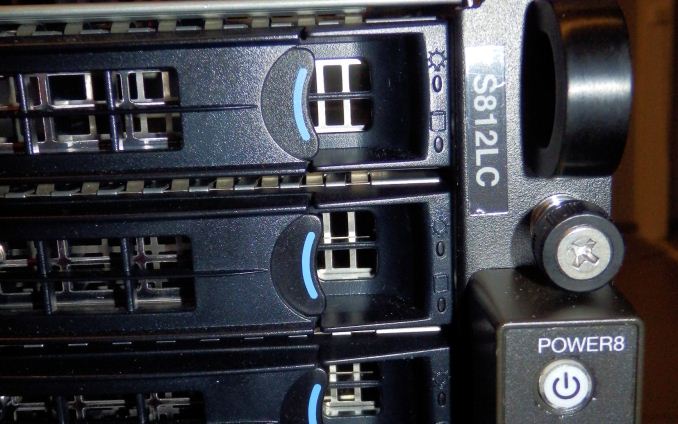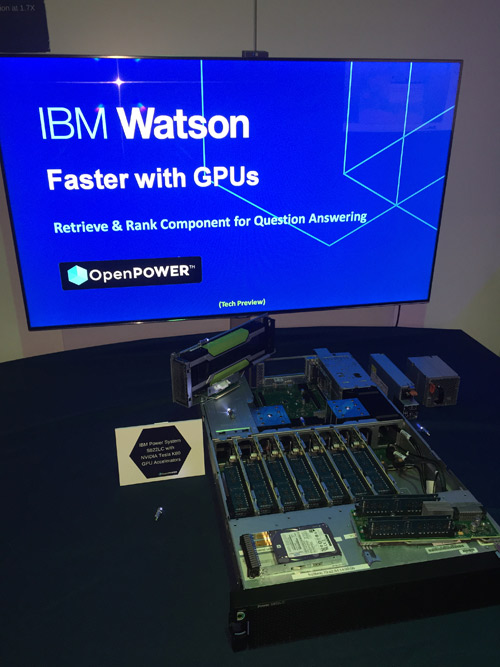Assessing IBM's POWER8, Part 2: Server Applications on OpenPOWER
by Johan De Gelas on September 15, 2016 8:01 AM EST
How serious are IBM's OpenPOWER efforts? It is a question we got a lot after publishing our reviews of the POWER8 and POWER8 servers. Despite the fact that IBM has launched several scale out servers, many people still do not see IBM as a challenger for Intel's midrange Xeon E5 business. Those doubts are understandable if you consider that Linux based systems are only 10% of IBM's Power systems sales. And some of those Linux based systems are high-end scale up servers. Although the available financial info gives us a very murky view, nobody doubts that the Linux based scale out servers are only a tiny part of IBM's revenue. Hence the doubts whether IBM is really serious about the much less profitable midrange server market.
At the same time, IBM's strongholds – mainframes, high-end servers and the associated lucrative software and consulting services – are in a slow but steady decline. Many years ago IBM put into motion plans to turn the ship around, by focusing on Cloud services (Softlayer& Bluemix), Watson (Cognitive applications, AI & Analytics) and ... OpenPOWER. If you pay close attention to what the company has been saying there is little doubt: these three initiatives will make or break IBM's future. And cloud services will be based upon scale out servers.
The story of Watson, the poster child of the new innovative IBM, is even more telling. Watson, probably the most advanced natural language processing software on the planet, started its career on typical IBM Big Iron: a cluster of 90 POWER 750 servers, containing 2880 Power7 CPUs and 16 TB of RAM. We were even surprised that this AI marvel was on the market for no more than 3 million dollars. The next generation for Watson cloud services will be (is?) based upon OpenPOWER hardware: a scale out dual POWER8 server with NVIDIA's K80 GPU accelerator as the basic building block. An OpenPOWER based Watson service is simply much cheaper and faster, even in IBM's own datacenters. But there is more to it than just IBM's internal affairs.
Google: "a simple config change"
Google seems to be quite enthusiastic about OpenPOWER. Google always experimented with different architectures, and told the world more than once that it was playing around with ARM and POWER based servers. However, the plans with OpenPOWER hardware are very tangible and require large investments: Google is actively developing a POWER9 server with Rackspace.

"Zaius, the OpenPOWER POWER9 server of Google and Rackspace"
Google has also publicly stated that "For most Googlers, enabling POWER is a config change". This far transcends the typical "we experimenting with that stuff in the labs".
So no wonder that IBM is giving this currently low revenue but very promising project such a high priority. And the pace increases: IBM just announced even more "OpenPOWER based" servers. The scale out server family is expanding quickly...











49 Comments
View All Comments
Eden-K121D - Thursday, September 15, 2016 - link
Can't wait for Power9Kevin G - Thursday, September 15, 2016 - link
Same here. I'm really curious about the differences between the four different dies IBM will be offering. Certainly the mix of two core types and IO types should fill the assorted niches found in the server market.rahvin - Thursday, September 15, 2016 - link
I can wait, it will be a market share failure like every other power because IBM will price it out of reach of any sensible price range. Going by previous attempts it will cost anywhere from 5-10X as much as an equivalent amount of x86 processing power. Something like $10K for the processor and a another $2-5 for the case, memory and motherboard and it will be equivalent to a quad x86 Xeon server that costs $5k for the same hardware.No one that doesn't need some special sauce it provides will buy them, particularly because you'd have to recompile all your software to use it. IBM has screwed up power so many times at this point that you'd have to be a fool to bet on it.
Eden-K121D - Friday, September 16, 2016 - link
Tell that to GoogleBrutalizer - Friday, September 16, 2016 - link
Power9 will be 50% - 125% faster than power8, according to IBM.http://www.nextplatform.com/wp-content/uploads/201...
On average it will be 75% faster.
The specjbb2013 benchmark is broken, SPEC discovered the benchmark can be vendor optimized to provide false results so they fixed it in specjbb2015. IBM have released specjbb2015 numbers for their S812LC server achieving 44.900 for max-jops and 13.000 for crticial-jops. That is almost as good as the Intel Xeon E5-2699v4 result. However, what is interesting is the critical-jops, which measures critical throughput under SLAs. IBM have said they will compete with Intel, with their power9.
(Of course, one SPARC M7 cpu achieves 120.600 max-jops and 60.300 critical-jops, that is 2.7x faster max-jops and 4.6x faster critical-jops. This is not using the built in hardware accelerators in SPARC. Next year the SPARC M8 arrives, which is 2x faster than M7. Today, Oracle have released six cpus in six years, each doubling performance (except the low cost S7, which is a crippled M7))
wingar - Friday, September 16, 2016 - link
I do like how you come with a comment that's incendiary towards POWER8 and POWER9, doing what you can to make it look worse... and then start touting how magical and wonderful SPARC M7 is. Using the same old Oracle-supplied performance claims without substantiating it. Funny, that. I think it stands out a little bit...But that's not what matters. If you run a simple google search, "site:anandtech.com brutalizer", you'll find comments with not a lot of variety. Usually commenting on anything x86 and POWER8, and in every single one (Except this one, actually! You actually reference an IBM supplied Spec result. However, you should link to it next time.) you tout the wonder of the latest SPARC of the time. Linking to Oracle-supplied benchmarks, on Oracles own site consistently concluding that Oracle outperforms their competitors. And every time you do this the comment seems to be as close to the top of the comment list as possible, for visibility.
Have some links.
http://www.anandtech.com/comments/10158/the-intel-...
http://www.anandtech.com/comments/9193/the-xeon-e7...
http://www.anandtech.com/comments/10230/ibm-nvidia...
http://www.anandtech.com/comments/9567/the-power-8...
http://www.anandtech.com/comments/7757/quad-ivy-br...
http://www.anandtech.com/comments/7852/intel-xeon-...
http://www.anandtech.com/comments/7285/intel-xeon-...
But I found a couple of comments you left that anti-everyone-not-Oracle. Have some links.
http://www.anandtech.com/comments/7334/a-look-at-a...
http://www.anandtech.com/comments/7371/understandi...
http://www.anandtech.com/comments/5831/amd-trinity...
I'm sure there's more comments like this where you're actually adding to the conversation but those are the few I found, and they're always unrelated to CPUs and the server market. They seem to perhaps reflect your own interests? But there is one thing to point out here and that the first religiously-pro-Oracle comment you made seemed to be in 2014. What happened then? Did you buy the account? Did someone start paying you? I don't know.
And hey, for fun I've actually posted this comment before to you, here's a link:
http://www.anandtech.com/comments/10435/assessing-...
Brutalizer - Friday, September 16, 2016 - link
I am not doing something to make power look worse, I put it in perspective and post other benchmark numbers from Intel and Oracle so people can compare. Yes, I am posting hard facts that can be indendently verified, or are you rejecting the benchmarks I post? Why? Why do you think it is a bad thing I post benchmarks from other vendors than IBM? You dont want people to be able to build their own opinion about power by comparing with other vendors? Why not? Why is it dangerous when someone quote benchmarks from other vendors? Whats the problem with that?If you insist, here is the SPARC M7 specjbb2015 results.
https://blogs.oracle.com/BestPerf/entry/201511_spe...
PowerOfFacts - Friday, September 16, 2016 - link
trollBrutalizer - Friday, September 16, 2016 - link
"...Using the same old Oracle-supplied performance claims without substantiating it..."Now this is the same old FUD from the IBM supporters. As i have explained, mathematicians can always prove their claims with links to benchmarks, white papers, resaerch papers, or point to common comp sci knowledge, etc. So you are in deep sh-t now. I can always post links to the numbers I claim. You claim I can not, and I spread unsubstantiated information - now you are lying about me.
Quote me on any number in any post - and I will post links to prove my numbers. If you ever find any post (you will not find any) where I make up numbers out of the blue to discredit IBM or Intel, you are correct that I post unsubstantiated claims. If you can not find any such posts by me, you are spreading FUD about me, and you lie about me. Now go ahead and quote me on any number where I make out things. I am waiting.
You are not really smart to claim a mathematician to not be able to prove his figures. I am now able to prove you are a liar and FUDer.
I think it is funny how the IBM supporters always FUD and try to discredit people, instead of countering the benchmark numbers. I post benchmark numbers, and instead of try to discuss the numbers you always attack me. That is not the scientific way, to avoid the hard facts and instead try to discredit the opponent. You should instead try to dissect my numbers and links instead of attacking me. But always, always, the IBM crowd does that " oh, he is an Oracle supporter" - so what? You are an IBM supporter! The difference is that I post numbers, and IBM crowd attacks me instead of countering with other numbers.
If you want to disprove my claims about Sparc, post numbers that disproves my benchmarks. Do not attack me, that does not win you any discussions.
SarahKerrigan - Friday, September 16, 2016 - link
Sure, it's true that on SPECjbb2015 a T7-1 beats a low-end IBM Turismo machine, an S812LC (with an entry price under $5000 list, compared to over $30000 entry price for the T7-1), by a factor of 2.7x on max-jops. It's also true that M7 came out almost a year and a half after P8 did, and that you can get a dual-CPU P8 server with that same processor, and 256GB RAM, for well under half of the list price of a single-CPU T7-1 with 128GB.Starting to see why IBM has over 70% of the non-x86 server market?